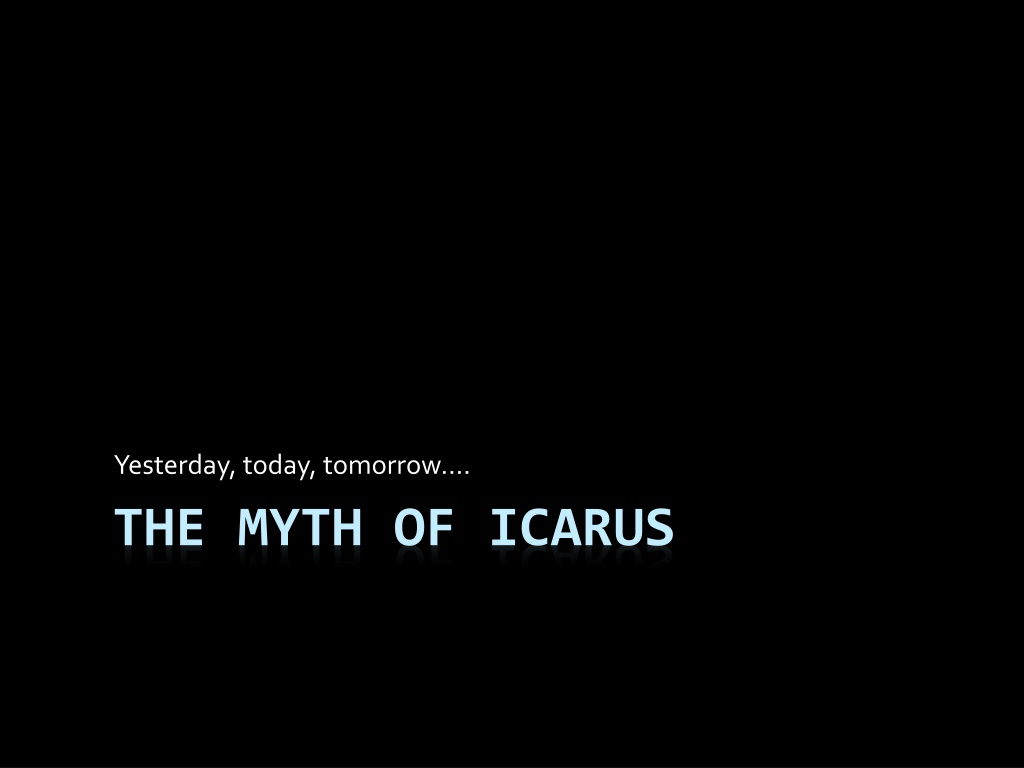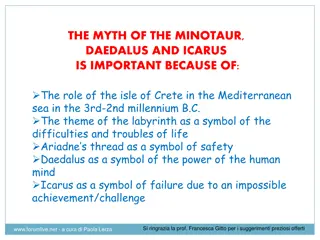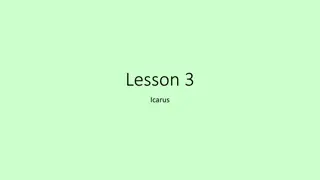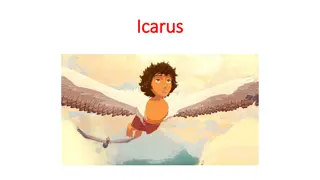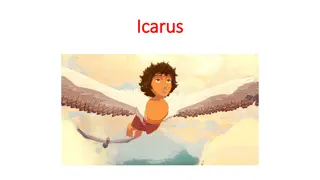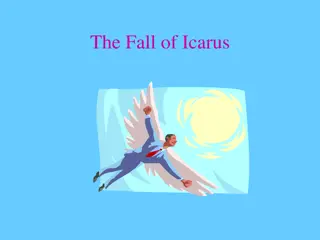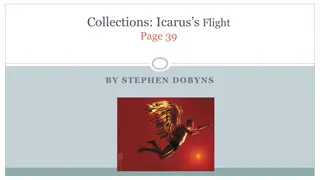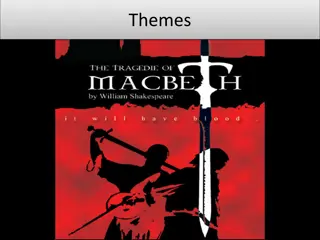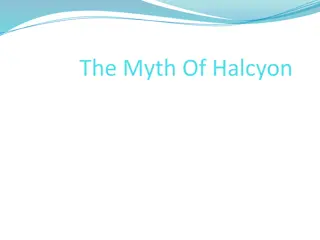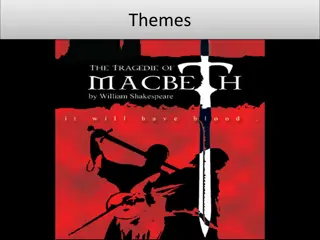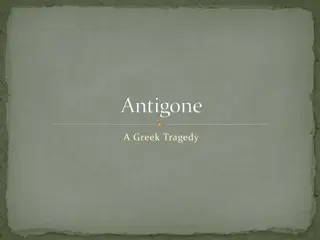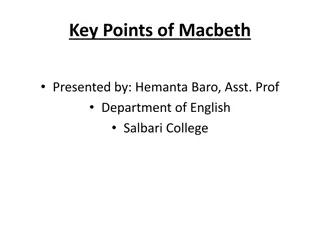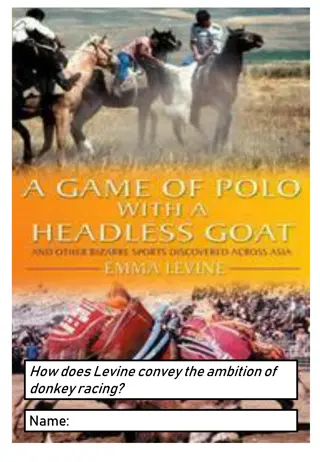The Myth of Icarus and Daedalus: A Tale of Ambition and Tragedy
In the ancient myth of Icarus and Daedalus, a father and son escape imprisonment in the Labyrinth of King Minos with wings made of wax and feathers. Daedalus warns Icarus not to fly too close to the sun, as the heat would melt his wings, but Icarus, young and enthusiastic, ignores the advice and tragically falls into the sea. This cautionary tale explores themes of ambition, disobedience, and the consequences of unchecked passion.
Download Presentation

Please find below an Image/Link to download the presentation.
The content on the website is provided AS IS for your information and personal use only. It may not be sold, licensed, or shared on other websites without obtaining consent from the author. Download presentation by click this link. If you encounter any issues during the download, it is possible that the publisher has removed the file from their server.
E N D
Presentation Transcript
Yesterday, today, tomorrow. THE MYTH OF ICARUS
Palace of Knossos http://www.google.com/images?q=palace+of+kn ossos&hl=en&rls=com.microsoft:en-us:IE- SearchBox&prmd=ivns&source=lnms&tbs=isch:1 &ei=sf9STbGNNcugtgeb_sWdCQ&sa=X&oi=mod e_link&ct=mode&cd=2&ved=0CBEQ_AUoAQ&bi w=1259&bih=847 While in Crete, Daedalus created the plan for the Minoan Palace of Knossos, one of the most important archaeological sites in Crete and Greece today. It was a magnificent architectural design and building, of 1,300 rooms, decorated with stunning frescoes and artifacts, saved until today. The sculpture of Ariadne in Knossos and many others in Elounda and Karia are also his.
The Icaraus and Daedalus story The Labyrinth was a maze built by Daedalus; King Minos wanted a building suitable to imprison the mythical monster Minotaur, and according to the myth, he used to imprison his enemies in the labyrinth, making sure that they would be killed by the monster. King Minos and Daedalus great relationship deteriorated; the most common explanation is that Daedalus was the one who advised Princess Ariadne to give Theseus the thread that helped him escape the Labyrinth, after killing the Minotaur. Minos was infuriated when found out about the betrayal and imprisoned Daedalus and his son Icarus in the Labyrinth. Knowing that his architectural creation was too complicated, Daedalus thought they could not come out on foot before the Minotaur got them. And even if they did, the shores of Crete were perfectly guarded, thus, the only way left was the air. Daedalus managed to create gigantic wings. He taught Icarus how to fly, but told him to keep away from the sun so the wax would not melt, destroying the wings. He also needed to avoid the water, which would weigh down the wings. The flight of Daedalus and Icarus was the first time that man managed to fight the laws of nature and beat gravity.
The story, continued Although he was warned, Icarus was too young and too enthusiastic about flying. He got excited by the thrill of flying and carried away by the amazing feeling of freedom and started flying high to salute the sun, diving low to the sea, and then up high again. His father Daedalus tried in vain to make young Icarus to understand that his behavior was dangerous, but Icarus soon saw his wings melting. Icarus fell into the sea and drowned. The Icarian Sea, where he fell, was named after him and there is also a nearby small island called Icaria.
"Icarus" Matisse, Henri 1947 This bold and playful image is one of twenty plates Matisse created to illustrate his groundbreaking book "Jazz." The illustrations derive from maquettes of cut and pasted colored papers, which were then printed using a stencil technique known as "pochoir." Image: 16-1/2 x 10-1/2 inches Metropolitan Museum of Art, New York http://www.metmuseum.org/
"The Lament for Icarus" Herbert Draper 1898 Oil on canvas 72 inches x 61 inches (roughly 6 x 5 ft) Tate Museum, London
"Icarus and Daedalus" D. Piola Oil on canvas 1670 (roughly 3' 8" x 4' 6") Private collection
"The Fall of Icarus" Rubens 1636 Oil on wood 10 inchesby 10 inches Mus es Royaux des Beaux-Arts, Brussels Web Gallery
Landscape with the Fall of Icarus Pieter Bruegelthe Elder c. 1558 Oil on canvas, mounted on wood, 29 in x 44 in MuseesRoyaux des Beaux-Arts de Belgique, Brussels
W. H. Auden American poet, (British born) 1907-1973 http://www.poets.org/poet.php/prmPID/120 http://poetrypages.lemon8.nl/life/musee/mus eebeauxarts.htm The following slides contain the poem published in 1938 about Bruegel'spainting:
Musee des Beaux Arts About suffering they were never wrong The Old Masters; how well, they understood Its human position; how it takes place While someone else is eating or opening a window or just walking dully along; How, when the aged are reverently, passionately waiting For the miraculous birth, there always must be Children who did not specially want it to happen, skating On a pond at the edge of the wood:
They never forgot That even the dreadful martyrdom must run its course Anyhow in a corner, some untidy spot Where the dogs go on with their doggy life and the torturer's horse Scratches its innocent behind on a tree. In Breughel's Icarus, for instance: how everything turns away Quite leisurely from the disaster; the ploughman may Have heard the splash, the forsaken cry,
But for him it was not an important failure; the sun shone As it had to on the white legs disappearing into the green Water;and the expensive delicate ship that must have seen Something amazing, a boy falling out of the sky, Had somewhere to get to and sailed calmly on.
Map of the Odyssey http://www.lindberglce.com/2009/1001_Getty/Getty2.htm
